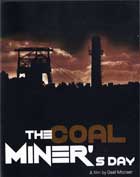
The Coal Miner’s Day ("Le Jour du Mineur" original French title) 2013
Distributed by Icarus Films, 32 Court St., 21st Floor, Brooklyn, NY 11201; 800-876-1710
Produced by Gaël Mocaër
Directed by Gaël Mocaër
DVD, color, 80 min., Russian/Ukrainian with English subtitles
General Adult
Ukraine, Coal Miners, Sociology
Date Entered: 07/09/2015
Reviewed by Dmitrii Sidorov, California State University, Long BeachThis remarkable film’s opening scene shows a landscape that at its foreground looks predominantly rural – pasture with early spring greenery dotted by chain of sleepy houses on its edge, horses are moving haystacks. That kind of scene is often stereotypically associated with much of Eastern Europe, yet the landscape contains a contrasting feature in its background: a hill left in Novovolynsk, North West Ukraine, as we are immediately informed, by mining at the Bouzhanska state-controlled mine. This is about the only reference to the geographical context above and around the mine. For instance, we are not provided with any opportunity to observe streets of the city or realize its proximity to the border with Poland and its distance from Donbass, the coal mining region in East Ukraine that has been so much affected by the recent geopolitical events between Ukraine and Russia. Instead, the film immediately takes its viewers on a close (and at time claustrophobically contained) tour of the mine. This exclusive focus on the work itself is arguably both an advantage and a deficiency of the film for non-European audiences. For better or worse, the film focuses exclusively on the mine and its workers excelling at immersion (perhaps at the expense of explanation).
Structurally, the film starts and ends with references to the celebration of Aug 29th, Miner’s Day, a holiday inherited from the Soviet Union. The film presents the celebration ceremony as a routine ritual repeated every year: an all-male band is playing popular music while women and men socialize (mostly separately and detached from the officials who deliver their predictable speeches about the importance and honor of the work). A minute of silence to commemorate those who died in the mine unites everyone in the scene. The rest of the film between the two visual references to the celebration ceremony is an immersive visual tour of miners’ challenging working conditions. The camera does not rush, allowing the experience of the time it takes to move down the mine, observe the rusty antiquated tools and dangerous working conditions, contemplate smoking breaks and follow the miners through stages of their activities including changing room and showers. The author (who admittedly does not understand local languages) does not engage in dialogue or provide his own narration allowing instead to listen to the bits of workers’ conversations (sometime with the camera) ranging from the men's banter to periodic subtle manifestations of dissatisfaction. Never too long nor in significant depth, not privileging any “hero” or telling anyone’s personal story, the mosaic of voices created provides an impressionistic albeit somewhat predictable group picture. Focusing on the production process, it leaves aside its re-production dimension, e.g., worker’s families lives before and after the work.
The end result is a memorable collective vérité portrait of a mostly visual sociological kind excelling in its immersive dimension. Yet I would not say the same for conveying the sense of “being there” because, again, the film does not provide broader geographical context especially valuable now after all the recent events in Ukraine. The film does not reach the metaphysical/metaphorical/artistic heights of Michael Glawogger’s 2005 masterpiece Workingman’s Death (its first part is on Ukraine’s coal mining). Nor is it as insightful and eye opening as Marianna Kaat’s 2010 film Auk Nr. 8 (2010) on children and illegal mining in the Donbass area. Nevertheless, this film is a remarkable achievement from production to direction and editing, the film is made by one person working without the usual crew. Perhaps because of that, this film allows spending some time with the team of miners at a remarkably short distance, documenting an experience that is very valuable to much of the audience on the other side of the Atlantic.